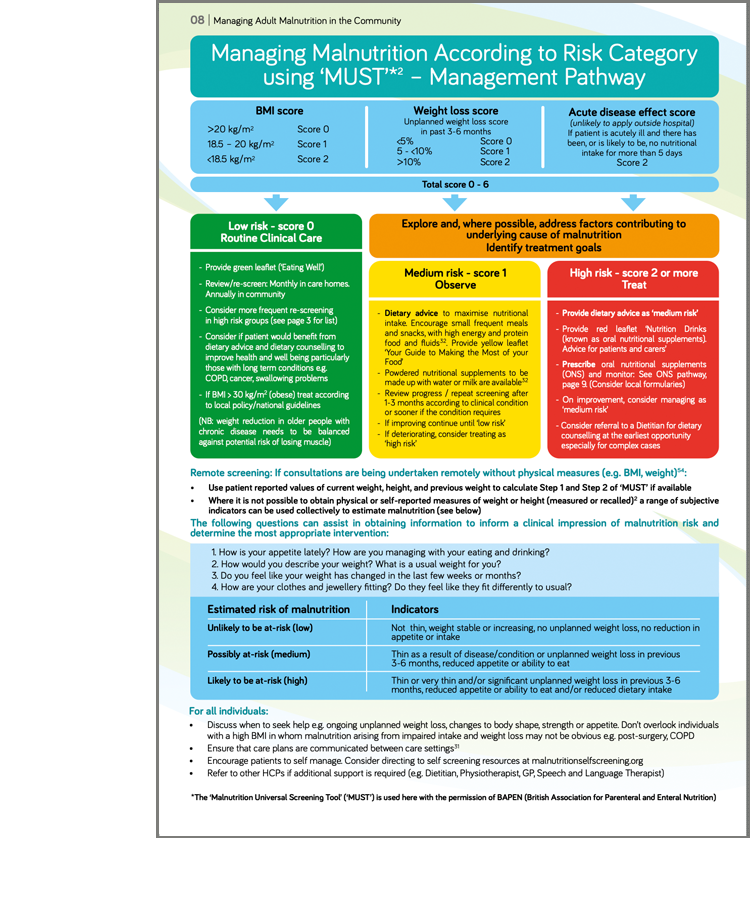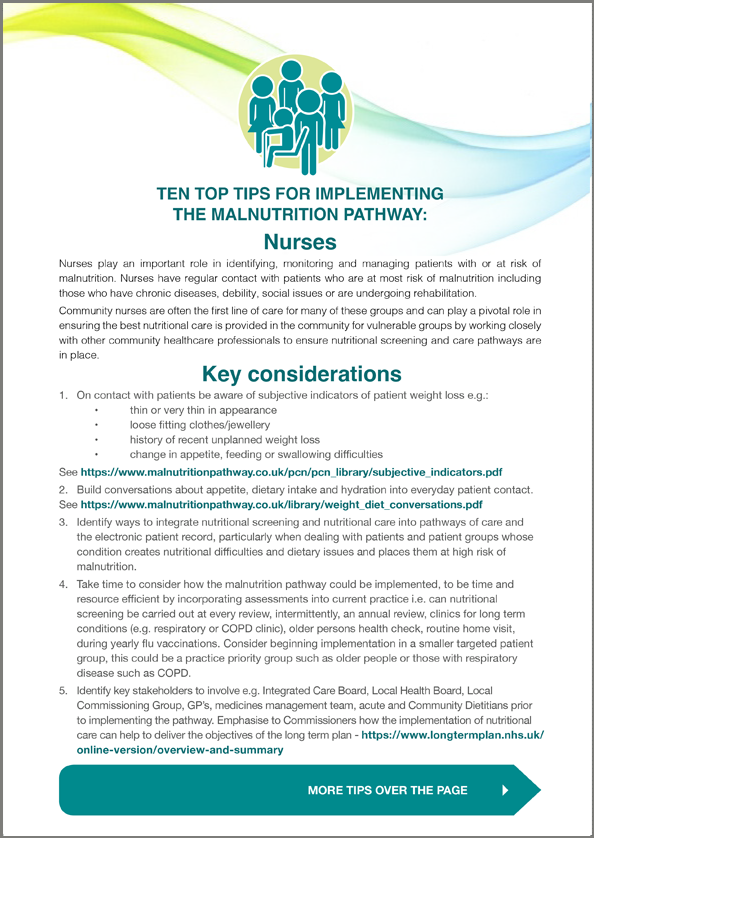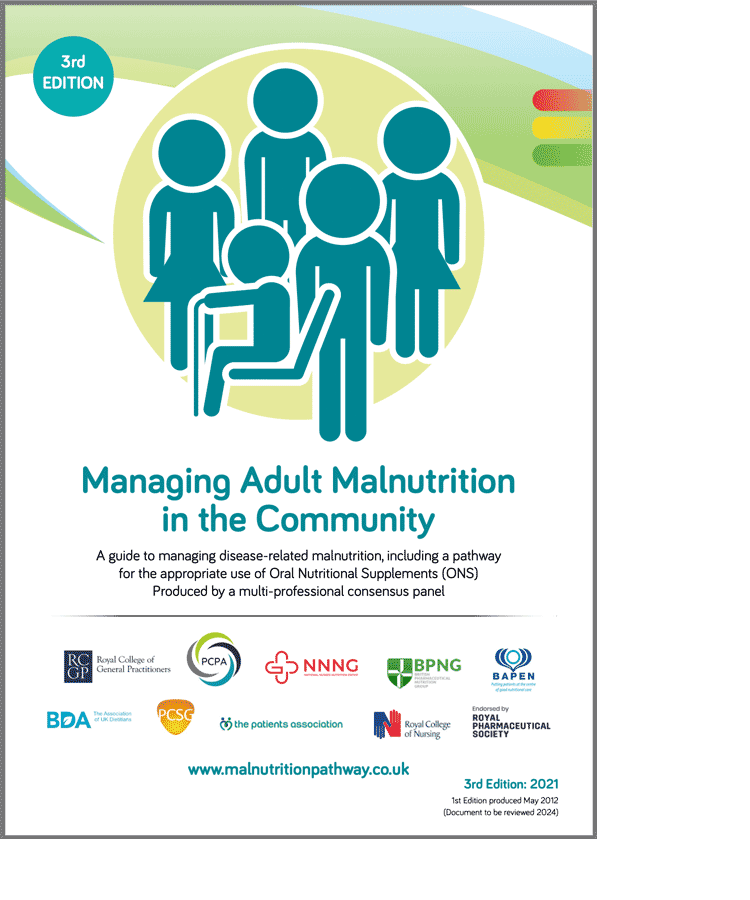Resources for Practice Nurses
Malnutrition Pathway Primary Care Network Portal
PCN RESOURCES HOME PAGE RESOURCES A-Z RETURN TO MAIN SITEPractice nurses play an important role in delivering care in general practice including screening and helping people to manage long term conditions. They can play an important role in identifying and managing patients with or at risk of malnutrition. As they can often see patients repeatedly on a long-term basis, they are well placed for monitoring weight and the implementation of any nutrition care plans.
Actions to consider include identification, assessment and treatment of malnutrition in the following ways:
- Remain alert to subjective indicators of malnutrition - such as unexplained weight loss, dysphagia, fatigue; further information can be found HERE
- Encourage patients that may be at risk to have regular weights and ensure sequential weight along with height is recorded in their electronic medical records with built in alerts for those with a decline in weight, a marker of risk for malnutrition
- For those at risk take action - Is there a team member who is best placed to manage the patient e.g. Dietitian? Or can you take action now to avoid unnecessary and potential irreversible deterioration in nutritional status? A management pathway for Managing Malnutrition According to Risk Category using ‘MUST’ can be found HERE
Screening
Consider incorporating nutrition screening: BAPEN MALNUTRITION UNIVERSAL SCREENING TOOL ‘MUST’ into pathways of care for members of the healthcare team to use particularly for high-risk groups such as the elderly and those with long term conditions or when there is clinical concern:

To treat and prevent repeated cycles of malnutrition requires an assessment to consider the potential underlying causes of malnutrition and determine the action needed:
- The Malnutrition Pathway has produced a useful list of questions to assist you in selecting the most appropriate course of action and dietary advice resources for the individual: GO TO RESOURCE SHEET
- Some treatments and medications can have side effects which can impact nutritional status, eating and drinking – do medications need changing or discontinuing?
- In some cases referral to relevant specialities may be required. Identifying the causes and symptoms, which are interfering with the ability to eat and drink, and addressing those that can be reversed or modified should be an integral component of the treatment plan: GO TO RESOURCE SHEET
- The Malnutrition Pathway website also includes specific advice for healthcare professionals dealing with patients with a number of conditions:
- PATIENTS WITH COPD
- PATIENTS WITH CANCER
- PATIENT HAS SWALLOWING DIFFICULTIES (DYSPHAGIA)
- SARCOPENIA (LOW MUSCLE MASS)
- PATIENT HAS SUFFERED A FALL
DIETARY ADVICE LEAFLETS are available to provide further ideas on managing the diet-related problems/symptoms. Local advice sheets may also be available.
It is important that patients understand the importance of adopting such dietary advice particularly if they have historically followed healthy eating plans and patterns, some discussion regarding following a more calorific diet may need to be had. ADVICE ON FOOD FORTIFICATION should be given. Refer those with eating and drinking difficulties on to other multidisciplinary team members such as Dietitians and Speech and Language Therapists
Discuss with GP if a prescription for oral nutritional supplements (ONS) may be appropriate for those identified at high risk: MORE INFORMATION
Discuss goals of the intervention with the patient, example of goals might include:
- weight maintenance/weight gain
- muscle gain, improved strength
- improved mobility/ability to undertake activities of daily living
- reduced infections
- optimal recovery or healing (e.g., from surgery or pressure ulcers)
- Monitor progress against goals and modify intervention appropriately, maintain communication channels and adjust care plan according to patient feedback:
- include checking compliance to ONS prescription ensuring that volume, format, type and flavour are appropriate for the patients’ needs
- Consider weight, strength, physical appearance, mood, appetite, ability to perform activities of daily living and compare with the goals originally set
- Discontinue ONS when adequate oral intake is established, goals/targets are achieved and the individual is stable and no longer at risk of malnutrition.
- Continue to monitor/make regular assessment of progress to check individual remains stable (consider relapsing conditions e.g. COPD, IBD).


